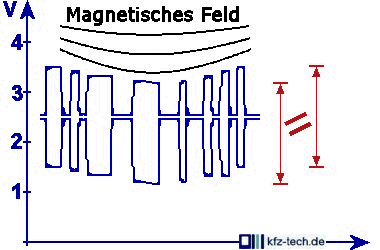
|
CAN-Bus 3 (Data Security)

| Magnets and transitional resistors have no chance. |
Digital data-lines have a clear advantage in the event of disturbances. If, e.g., the signal from the fuel tank transducer is transfered analog, every - be it only very small - disturbance, perhaps through an (electric)
magnet or through transitional resistances, has an affect. Should only 4 volts instead of 5 volts be received, then, in theory, the fuel-gauge would show 20% less. In the case of a digital transfer there is no such loss of
information, as long as the bits can be recognised. The undefined range when transferring 5 V signals should lie between 2 - 3,5 volts. All voltage levels above- and below this are unambibgious.
| Even more data-security through CAN_H and CAN_L. |
The designers of the CAN-Busses were not yet satisfied. Mostly one takes two data-lines, CAN_H(igh) and CAN_L(ow). Thereby, one line tranfers the exactly inverted signal of the other. If then, CAN_H increases the
voltage, then CAN_L reduces it and vice versa. The receivers on the CAN-Bus, e.g., in the Highspeed-Bus, evaluate the difference between the two. Should the voltage difference exceed a certain value, the transfer of
the bit is considered valid. Should a disturbance occur in both data-lines, then both are shifted by a certain voltage, in either the plus- or the minus direction. The difference however, remains constant.
| Varying voltage ranges depending on the BUS-speed. |
Theoretically, in a comfort data-bus, CAN_H oscillates between 0 and 5 volts, Can_L between 5 and 0 volts. Thus, if one measures the tension, instead of 5 V with CAN_H, there are only approx. 4,3 V and with CAN_L,
instead of 0 V, 0,7 V. The respective difference of 0,7 V is due to the diode-path of the transistor circuit in the IO unit of the individual BUS-participants. You can find the level for the faster Busses (e.g., for the engine) in
the table shown below. Recessive (1) is the voltage level, when no data-transfer is taking place. 05/07
| Comfort | Dominant | Recessive |
| CAN_H | approx. 4,3 V | approx. 0 V |
| CAN_L | approx. 0,7 V | approx. 5 V |
| | High-Speed | Dominant | Recessive |
| CAN_H | approx. 3,5 V | approx. 2,5 V |
| CAN_L | approx. 1,5 V | approx. 2,5 V |
|
|
|